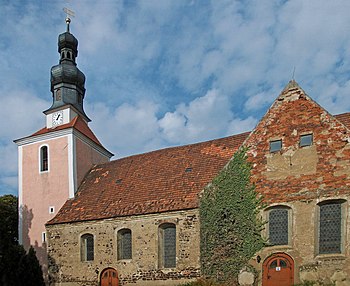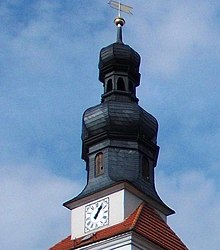Parish church of Wahrenbrück
The Protestant parish church of Wahrenbrück is a listed church building in the district of Wahrenbrück in the small town of Uebigau-Wahrenbrück in the Elbe-Elster district in southern Brandenburg . Here it is, surrounded by a cemetery in the city center.
The church is considered to be the baptistery of the musicians, Graun brothers , who were born in Wahrenbrück and who are among the main representatives of the “ First Berlin Song School ”, established in the 18th century . In terms of tourism, the church is accessible through the regional church road Elbe-Elster project and the cycle paths leading along the Black Elster .
Building description and history
The parish church in Wahrenbrück, which was first mentioned in a document in 1340, originally dates from the 13th century. It was probably built on the remains of a previous building from the 12th century, which was made of lawn iron stone . One of these remains is said to be a round arched gate in the north wall of the building that has since been closed.
The Wahrenbrück church is a rectangular, plastered, late Romanesque hall building, the nave of which consists mainly of lawn iron stone. In the west of the nave there is a recessed church tower with an almost square floor plan, which is provided with a hipped roof. On top of this is a smaller but also square roof turret with a tail hood and lantern . In the east there is a recessed rectangular choir with a polygonal east end. In the north of the choir you can see a sacristy extension with a patronage box above. On the south side of the choir there is a transept-like extension. The architectural style of the building is assigned to the late Romanesque .
The building underwent the first changes at the end of the 13th century when it received its choir. The church tower and the sacristy were built towards the end of the 15th century. After the church was badly damaged by a large city fire at the beginning of the 18th century, the building was rebuilt in 1715 with a simultaneous extension to the choir. A patronage box and a staircase were built above the sacristy. This work also gave the church tower its current shape. There had been serious city fires during this period in 1707, 1710 and 1714. The town fire of 1707 lost 33 farms, that of 1710 8 farms and the school. There was another fire in 1714, which destroyed 22 houses and the upper parish.
From the fall of the Wall , some restoration and renovation work was carried out on the church, including the church tower.
Equipment (selection)
The interior of the church is characterized by a wooden ceiling and a three-sided gallery . The sacristy has a narrow barrel vault as the ceiling. The interior was almost completely renewed after a fire in 1898 with the parapet of the patron's box and the chairs. The interior of the southern extension, which was connected to the choir by means of an open round arch, has a flat roof. Some changes were made at the end of the 1960s, including on the gallery in the south extension.
The church has a wooden altarpiece that dates from the late 17th century. In the main field there is a painting showing the resurrection of Christ. Another in the essay shows his ascension . The altar is crowned by a carved crucifix . After the fire in 1898, the altar was made dark. The wooden pulpit, also from the 17th century, was modified by the works in 1898 and 1965. Paintings of the evangelists can be seen in its parapet. There is also an octagonal wooden baptism in the church . This was created in the second half of the 17th century.
organ
Today's organ was created in 1984 by the Bad Liebenwerda organ building company Voigt . A 130 year old organ originally located here was removed beforehand. If the old organ was still on one of the galleries, the new instrument can be found next to the pulpit.
The instrument has a mechanical drawer , twelve stops on two manuals and a pedal .
The disposition :
|
|
|
|||||||||||||||||||||||||||||
- Coupling : II / I, I / P, II / P
Tombs
Inside the church, on the east wall, there is a double tombstone with ancestral specimen for Magdalena von Weltewitz († 1637). On the outer east wall there are three gravestones from the 18th century.
The church is also surrounded by the local cemetery. The father of the Graun brothers , the royal Polish and Electoral Saxon excise collector August Graun († 1734) was buried here.
Rectory and parish of Wahrenbrück
Parish
In addition to the city itself, the parish of Wahrenbrück originally comprised 12 of the surrounding villages, which, before they had their own schools, also sent their children to the city choir of Wahrenbrück for lessons. There is documentary evidence of a schoolmaster employed in Wahrenbrück as early as the first half of the 16th century. Initially, however, he also accompanied the offices of sexton and town clerk.
The Wahrenbrück Church became a branch church of the Dobrilugk Monastery in 1480 , which led to conflicts in the course of the Reformation from 1525, as the monastery sent its own pastors to its branches and the Wahrenbrück pastor was not particularly fond of the new doctrine. In addition, the monastery probably also levied unlawful taxes and took out some rights which, in the opinion of the community, it actually did not have. However, such disputes between Wahrenbrück and the monastery had been going on for over 200 years. Ultimately, the community complained to the Saxon elector and the case ended up with the Liebenwerdaer Amtsschösser . After an initial agreement had been reached, the pastor from Wahrenbrück was dismissed as unsuitable the following year and the parish re-elected its own pastor.
Today the parish area still includes the churches in Kosilenzien and Bönitz . The parish area of Wahrenbrück is located in the Bad Liebenwerda parish of the Evangelical Church in Central Germany .
Rectory
Like the parish church in Wahrenbrück, the neighboring rectory is also a listed building. The rectory is the successor to the upper parish, which burned down in the town fire in 1714. The upper floor of the building with a mansard roof was built in half-timbered construction. The house was built in 1722 and 1723. The associated farm building is also under monument protection, which has an L-shaped floor plan and was built at the same time as the main building as a field and brick building.
Graun brothers
The city of Wahrenbrück is closely linked to the life and work of the Graun brothers who were born here . The parish church in Wahrenbrück is considered to be their baptistery. The brothers are the three composers August Friedrich Graun (1698 / 99–1765), Johann Gottlieb Graun (1703–1771) and Carl Heinrich Graun (1704–1759). The eldest of the brothers worked for many years in Merseburg as cathedral choirmaster and was relatively unknown. The two younger brothers, on the other hand, were quite successful in their day. You are one of the main representatives of the “ First Berlin Song School ” and worked as concert or court music director in Berlin .
In Wahrenbrück, among other things, the Graun monument and the Graun Society Wahrenbrück remember the brothers. The Graundenkmal was once erected together with citizens of the town of Bad Liebenwerda , a few kilometers away . A permanent exhibition on the life and work of the Graun brothers can be found here in the local district museum .
literature
- Georg Dehio : Handbook of the German art monuments - Brandenburg . 2nd Edition. 2012, ISBN 978-3-422-03123-4 , pp. 1133 .
- Cultural Office of the Elbe-Elster District, Bad Liebenwerda District Museum, Sparkasse Elbe-Elster (publisher): Elbe-Elster organ landscape . Herzberg / Elster 2005, p. 58-59 .
- Sascha Bütow: The Wahrenbrück community in dispute with the “papist” monks from the Dobrilugk monastery . In: altstadtlust . No. 2 , 2016, p. 43-45 .
Web links
- The parish church of Wahrenbrück on the homepage of the city of Uebigau-Wahrenbrück
- Internet presence of Kirchenstrasse Elbe-Elster
- Information on the parish area of Wahrenbrück on the homepage of the church district Bad Liebenwerda
Notes and individual references
- ↑ a b c d e database of the Brandenburg State Office for the Preservation of Monuments and the State Archaeological Museum ( Memento of the original from December 9, 2017 in the Internet Archive ) Info: The archive link was automatically inserted and not yet checked. Please check the original and archive link according to the instructions and then remove this notice. , accessed November 3, 2017.
- ↑ Internet presence of "Kirchenstrasse Elbe-Elster" , accessed on November 3, 2017.
- ↑ a b c d e f g h Georg Dehio: Handbook of German Art Monuments - Brandenburg . 2nd Edition. 2012, ISBN 978-3-422-03123-4 , pp. 1133 .
- ^ Z: Wahrenbrück . In: The Black Magpie . No. 16 , 1925 (free local history supplement to the Liebenwerdaer Kreisblatt ).
- ↑ Matthäus Karl Fitzkow : On the older history of the city of Liebenwerda and its district area . Ed .: District Museum Bad Liebenwerda. Bad Liebenwerda 1961, p. 102-103 .
- ↑ City administration Uebigau-Wahrenbrück (Hsg): Living together in Uebigau-Wahrenbrück. (Information brochure, pdf), 2016
- ↑ a b Steven Micksch: Church with a lot of potential, but tight budget. In: Lausitzer Rundschau , December 9, 2008.
- ↑ a b c cultural office of the Elbe-Elster district, Bad Liebenwerda district museum, Sparkasse Elbe-Elster (ed.): Elbe-Elster organ landscape . Herzberg / Elster 2005, p. 58-59 .
- ^ Organ database , accessed on November 3, 2017.
- ↑ a b Internet presence of the Graun-Gesellschaft Wahrenbrück , accessed on November 4, 2017.
- ↑ All sorts of things from school life in the good old days, especially in the parish of Wahrenbrück . In: The Black Magpie . No. 16 , 1906 (free local history supplement to the Liebenwerdaer Kreisblatt ).
- ↑ Matthäus Karl Fitzkow : On the older history of the city of Liebenwerda and its district area . Ed .: District Museum Bad Liebenwerda. Bad Liebenwerda 1961, p. 56 to 58 .
- ^ Sascha Bütow: The community of Wahrenbrück in dispute with the "papist" monks from the Dobrilugk monastery . In: altstadtlust . No. 2 , 2016, p. 43-45 .
- ↑ Friedrich Stoy : Wahrenbrück in his ecclesiastical relations with the Dobrilugk monastery . In: The Black Magpie . No. 377 , 1929 (free local history supplement to the Liebenwerdaer Kreisblatt ).
- ↑ Internet presence of the Bad Liebenwerda church district , accessed on November 4, 2017.
- ^ Georg Dehio: Handbook of German Art Monuments - Brandenburg . 2nd Edition. 2012, ISBN 978-3-422-03123-4 , pp. 1134 .
- ^ R: The Graun monument in Wahrenbrück . In: The Black Magpie . No. 116 , 1909 (local history supplement to the Liebenwerdaer Kreisblatt ).
Coordinates: 51 ° 33 ′ 3.1 ″ N , 13 ° 21 ′ 49.5 ″ E




